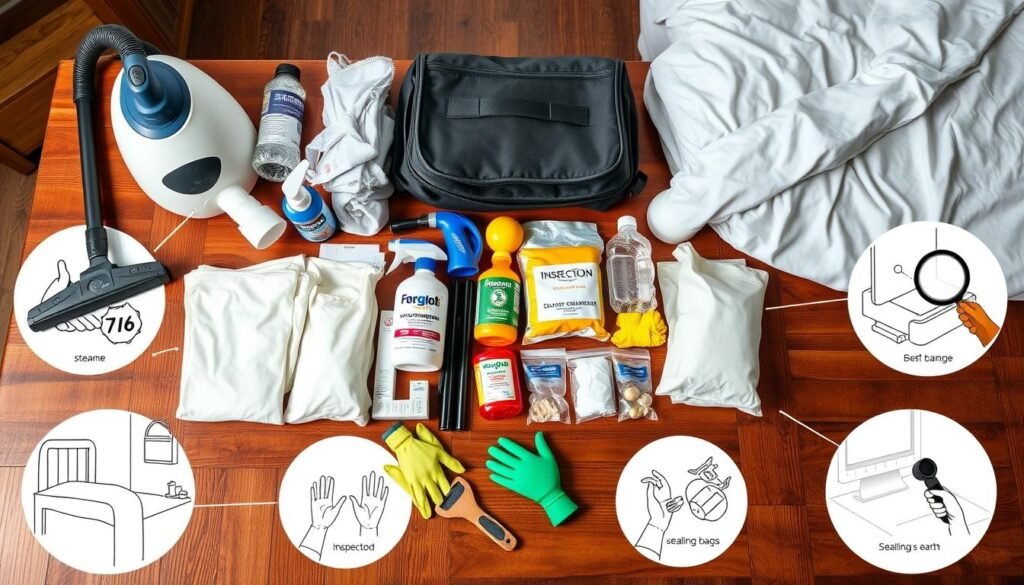Dealing with bed bugs is stressful and unsettling. These tiny, night-loving bugs love human blood. This can lead to discomfort, worry, and sleepless nights. It’s crucial to tackle bed bug issues quickly and well for your health. Luckily, there are many ways to get rid of bed bugs. This includes professional pest control and do-it-yourself (DIY) tips. Knowing your options is key. It will help you get rid of these annoying bugs and sleep well again.
Key Takeaways
- Bed bugs are small insects that feed on human blood.
- Quick action is essential for effective bed bug removal.
- Professional extermination services offer reliable solutions.
- Many DIY strategies can aid in pest control efforts.
- Identifying signs of infestation is crucial for timely intervention.
Understanding Bed Bugs
Bed bugs are tiny, hard-to-find insects that make pest control difficult. Their insect biology is complex, with a life cycle that includes eggs, nymphs, and adults. Adult bed bugs are about 4 to 5 mm long. They are oval, flat, and can hide in small places.
These pests are active at night, feeding on human blood while people sleep. They can feed for 3 to 10 minutes. They are especially drawn to sleeping areas because of the warmth.
Bed bugs love messy spaces where they can easily hide. They hide in furniture, wall cracks, and tiny crevices. Knowing how they behave helps in fighting them off. This knowledge lets people and professionals find and stop infestations early.
| Life Stage | Characteristics | Duration |
|---|---|---|
| Egg | Size: 1 mm, white and sticky | 5-10 days |
| Nymph | Smaller than adults, require blood meals to molt | 5-6 weeks to reach adulthood |
| Adult | Color: Brownish, size: 4-5 mm | Can live several months without feeding |
Learning a lot about bed bug insect biology and where they live helps control them better. Being proactive is key to avoiding and controlling infestations.
Signs of a Bed Bug Infestation
Finding out if you have bed bugs is very important. It helps to start getting rid of them early. This makes it easier to deal with them and stops them from spreading more.
Look for these signs to know if you have an infestation:
- Bite Marks: You might see small itchy spots on your skin. They usually group together. This happens after bed bugs bite you at night.
- Blood Stains: Rust-colored stains on your sheets or pillowcases can show up. These stains are from bed bugs after they feed and get crushed.
- Visible Bed Bugs: If you see bugs that look like apple seeds, it means you have a lot of them.
- Shed Exoskeletons: Finding thin, empty skins shows that bed bugs are growing. These skins are left in places where bed bugs hide.
Knowing these signs helps you get ahead of the problem. Experts say you should write down what you find. This helps the pros understand the issue better. Then, they can fix it the right way.
Importance of Swift Bed Bug Removal
Timely 除臭蟲 is crucial in stopping infestations. Quick action reduces the discomfort from bites. It also stops the bugs from spreading in the home.
Bed bugs reproduce fast if not removed. This makes the infestation grow. A larger infestation is harder to control.
Having bed bugs can seriously affect your mental health. It’s linked to more anxiety and loss of sleep. Feeling embarrassed can make people avoid social situations.
Quickly dealing with bed bugs helps people feel safe. It brings peace of mind.
It’s important to prevent bed bugs to avoid these problems. Being proactive helps a lot. Using professional help for fast removal keeps your home comfortable.
Professional Extermination Services
Dealing with bed bugs? Professional extermination can really help. Experts bring knowledge and advanced methods for effective removal. They go beyond simple DIY fixes, aiming for lasting solutions right at the problem’s heart.
Pest control companies provide several benefits over DIY efforts. They have the latest tools and safe insecticides. Their teams are well-trained, spotting infestations early and tailoring their approach. Thanks to their skills, even tough bed bugs don’t stand a chance.
Professional extermination might cost more upfront than DIY. But it often pays off in the long run. Studies show that ignoring bed bugs can lead to higher costs over time. Repeated DIY attempts just don’t cut it. Below, see a table comparing professional services to DIY techniques:
| Feature | Professional Extermination | DIY Methods |
|---|---|---|
| Effectiveness | High, long-lasting results | Variable, often temporary |
| Expert Knowledge | Specialized training | General information |
| Tools and Equipment | Advanced, industry-grade | Household items |
| Safety | Eco-friendly options available | Risk of improper use |
| Cost | Higher upfront but long-term savings | Lower initial cost but recurring expenses |
Choosing experts for bed bug issues is smart. It saves time, effort, and worry. Working with pest control means a thorough clean-up and prevention. That ensures a bug-free home.
Types of Bed Bug Removal Methods
Dealing with bed bugs requires knowing the best pest control methods. Insecticide treatment and heat treatment are highly effective. Each has its own uses, pros, and things to consider. So, picking the right one is important.
Insecticide Treatment
Insecticide treatment uses chemicals to kill bed bugs and eggs. You can find sprays, powders, and foggers. Pyrethroids, neonicotinoids, and insect growth regulators are often used. They attack the bugs’ nervous system or prevent them from growing. Using these products correctly is vital to be safe and effective.
Heat Treatment
Heat treatment kills bed bugs with high temperatures. The area must reach at least 120°F (49°C) to kill bugs and eggs. It’s great because it finds bugs hidden away without harmful leftovers. Plus, heat treatment can usually be done in one day. This makes it a quick solution for many.
DIY Bed Bug Removal Strategies
Dealing with a bed bug problem can lead many people to try solving it on their own. Using DIY methods can help get rid of these annoying bugs. It’s essential to check your home carefully to find where they’re hiding and figure out a plan.
Home Inspection Techniques
Finding bed bugs starts with a good look around your home. Here are ways to improve your search:
- Look at mattress seams and bed frames for tiny, rust-colored spots that show bed bug waste.
- Examine furniture crevices, cushions, and behind baseboards for their hiding spots.
- Inspect luggage, backpacks, and other items for bed bugs after you travel.
- Use a flashlight to see in dark areas, helping you find these sneaky bugs.
Using Mattress Encasements
Mattress encasements are great for fighting bed bugs. They stop these pests from getting into or out of your mattress. Here’s why they’re useful:
- They keep mattresses safe and act like a shield against bed bugs.
- These covers make cleaning simple and help avoid new infestations.
- They give you confidence that you’re preventing bed bug problems.

Using these DIY methods can really help decrease bed bugs in your house. Checking your home well and using mattress covers are key steps to stay bug-free.
Choosing the Right Pest Control Company
Choosing the right pest control company is key to getting rid of bed bugs. When looking for pest control services, keep these points in mind:
- Experience: Go for companies with lots of experience in handling bed bugs. Experts are likely to have faced many situations and know the best solutions.
- Customer Reviews: Look at pest control company reviews from past customers. Good reviews can tell you a lot about a company’s trustworthiness and quality of service.
- Services Offered: Make sure they offer various services, like chemical and non-chemical treatments for complete extermination.
- Certifications and Licenses: Check if they have the needed licenses and certifications. This shows they meet the required standards.
Some companies may provide free inspections or consultations to help you decide. Comparing quotes from several companies helps you understand different prices and what they offer.
Bed Bug Removal: Steps to Take When You Discover an Infestation
Finding a bed bug infestation is very stressful. It’s important to take action right away to handle it. Start by isolating affected items. Put them in plastic bags to stop them from spreading in your home. This keeps the bed bugs from moving to new areas.
Then, get in touch with a professional pest control team. These experts have the right knowledge and tools for bed bug removal. They can look at your situation and pick the best way to fix it.
It’s also key to document the infestation. Take clear pictures of the bed bugs and any bites or skin reactions. This helps the pros understand how bad the infestation is and plan their attack.
Consider following these immediate actions:
- Identify the extent of the infestation.
- Remove bedding and clothing, washing them in hot water.
- Vacuum the entire area, focusing on cracks and crevices.
These steps are good to take while waiting for professional help. They offer a clear plan for fighting bed bugs. Following them can make getting rid of bed bugs more likely to work.
| Infestation Steps | Immediate Actions |
|---|---|
| Isolate affected items | Seal in plastic bags |
| Contact pest control | Schedule an inspection |
| Document evidence | Take photos of signs |
| Wash bedding | Use hot water |
| Vacuum thoroughly | Target cracks and crevices |
Preventing Future Bed Bug Infestations
Keeping your home free from bed bugs is crucial. Regular upkeep can greatly lower the chances of infestations. A clean and tidy environment not only improves your living area but also keeps pests away.
Best Practices for Home Maintenance
For effective prevention, adopt these home maintenance tips:
- Conduct regular inspections of mattresses, bedding, and furniture.
- Keep your home clean by vacuuming frequently, especially areas such as under beds and behind furniture.
- Store clothing and belongings in sealed containers, particularly if they are kept in storage units.
- Exercise caution when bringing in second-hand furniture or clothing. Inspect them thoroughly for any signs of bed bugs.
Using Residual Insecticides
Using residual insecticides can help prevent bed bugs. These products protect your home over time. Choose ones made especially for bed bugs. Always follow the instructions for safe and effective use.
Keep your home clean and use insecticides wisely to fight bed bugs. These steps can protect your home and give you peace of mind.

Conclusion
Getting rid of bed bugs is key to a cozy home. Tackling this issue quickly reduces stress and stops other problems. This guide explained spotting bed bugs, removal techniques, and how to avoid them.
Choosing DIY or professional help is crucial. There are many methods like heating and chemicals for getting rid of bugs. Your comfort is important. With the right steps, you can have a bed bug-free house.
Being watchful and keeping your home clean prevents more bugs. Being ahead of the problem and checking your home often is vital. Start now to ensure good sleep without worrying about bed bugs!










